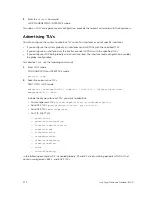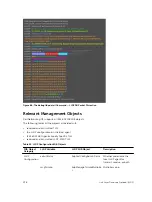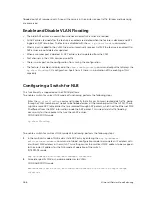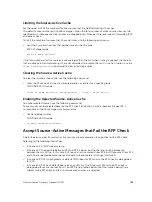
• With NLB feature enabled, after learning the NLB ARP entry, all the subsequent traffic is flooded on all
ports in VLAN1.
With NLB, the data frame is forwarded to all the servers for them to perform load-balancing.
NLB Multicast Mode Scenario
Consider a sample topology in which four servers, namely S1 through S4, are configured as a cluster or a
farm. This set of servers is connected to a Layer 3 switch, which in turn is connected to the end-clients.
They contain a single multicast MAC address (MAC-Cluster: 03-00-5E-11-11-11).
In the multicast NLB mode, a static ARP configuration command is configured to associate the cluster IP
address with a multicast cluster MAC address.
With multicast NLB mode, the data is forwarded to all the servers based on the port specified using the
Layer 2 multicast command, which is the
mac-address-table static <multicast_mac>
multicast vlan <vlan_id> output-range <port1>, <port2>
command in CONFIGURATION
mode.
Limitations With Enabling NLB on Switches
The following limitations apply to switches on which you configure NLB:
• The NLB unicast mode uses switch flooding to transmit all packets to all the servers that are part of
the VLAN. When a large volume of traffic is processed, the clustering performance might be impacted
in a small way. This limitation is applicable to switches that perform unicast flooding in the software.
• The
ip vlan-flooding
command applies globally across the system and for all VLANs. In cases
where the NLB is applicable and the ARP replies contain a discrepancy in the Ethernet SHA and ARP
header SHA frames, a flooding of packets over the relevant VLAN occurs.
• The maximum number of concurrent clusters that is supported is eight.
Benefits and Working of Microsoft Clustering
Microsoft clustering allows multiple servers using Microsoft Windows to be represented by one MAC
address and IP address in order to provide transparent failover or balancing. Dell Networking OS does not
recognize server clusters by default; it must be configured to do so. When an ARP request is sent to a
server cluster, either the active server or all the servers send a reply, depending on the cluster
configuration. If the active server sends a reply, the Dell switch learns the active server’s MAC address. If
all servers reply, the switch registers only the last received ARP reply, and the switch learns one server’s
actual MAC address; the virtual MAC address is never learned. Because the virtual MAC address is never
learned, traffic is forwarded to only one server rather than the entire cluster, and failover and balancing
are not preserved.
To preserve failover and balancing, the switch forwards the traffic destined for the server cluster to all
member ports in the VLAN connected to the cluster. To ensure that this happens, you must configure the
ip vlan-flooding
command on the Dell switch at the time that the Microsoft cluster is configured.
The server MAC address is given in the Ethernet frame header of the ARP reply, while the virtual MAC
address representing the cluster is given in the payload. Then, all the traffic destined for the cluster is
Microsoft Network Load Balancing
485
Summary of Contents for Z9000
Page 1: ...Dell Configuration Guide for the Z9000 System 9 7 0 0 ...
Page 80: ...grub reboot 80 Management ...
Page 128: ... 0 Te 1 1 Te 1 2 rx Flow N A N A 128 Access Control Lists ACLs ...
Page 491: ...Figure 70 Configuring OSPF and BGP for MSDP Multicast Source Discovery Protocol MSDP 491 ...
Page 496: ...Figure 73 MSDP Default Peer Scenario 1 496 Multicast Source Discovery Protocol MSDP ...
Page 497: ...Figure 74 MSDP Default Peer Scenario 2 Multicast Source Discovery Protocol MSDP 497 ...
Page 498: ...Figure 75 MSDP Default Peer Scenario 3 498 Multicast Source Discovery Protocol MSDP ...
Page 760: ...Figure 100 Single and Double Tag TPID Match 760 Service Provider Bridging ...
Page 761: ...Figure 101 Single and Double Tag First byte TPID Match Service Provider Bridging 761 ...














































